Unilever's Business Strategy: Analysis, Objectives, Growth
VerifiedAdded on 2023/06/07
|15
|4814
|210
Report
AI Summary
This report provides a comprehensive analysis of Unilever's business strategy, employing frameworks such as PESTLE, SWOT, and VRIO to evaluate the company's internal and external environments. It delves into Unilever's competitive advantages, strategic objectives, and potential growth strategies. The analysis covers political, economic, sociological, technological, legal, and environmental factors impacting Unilever's operations. Furthermore, the report examines Unilever's strengths, weaknesses, opportunities, and threats, along with an assessment of its resources based on the VRIO framework. Porter's Five Forces model is used to analyze the competitive intensity within Unilever's industry. The report concludes with recommendations for growth strategies and methods for monitoring their success in the competitive market.
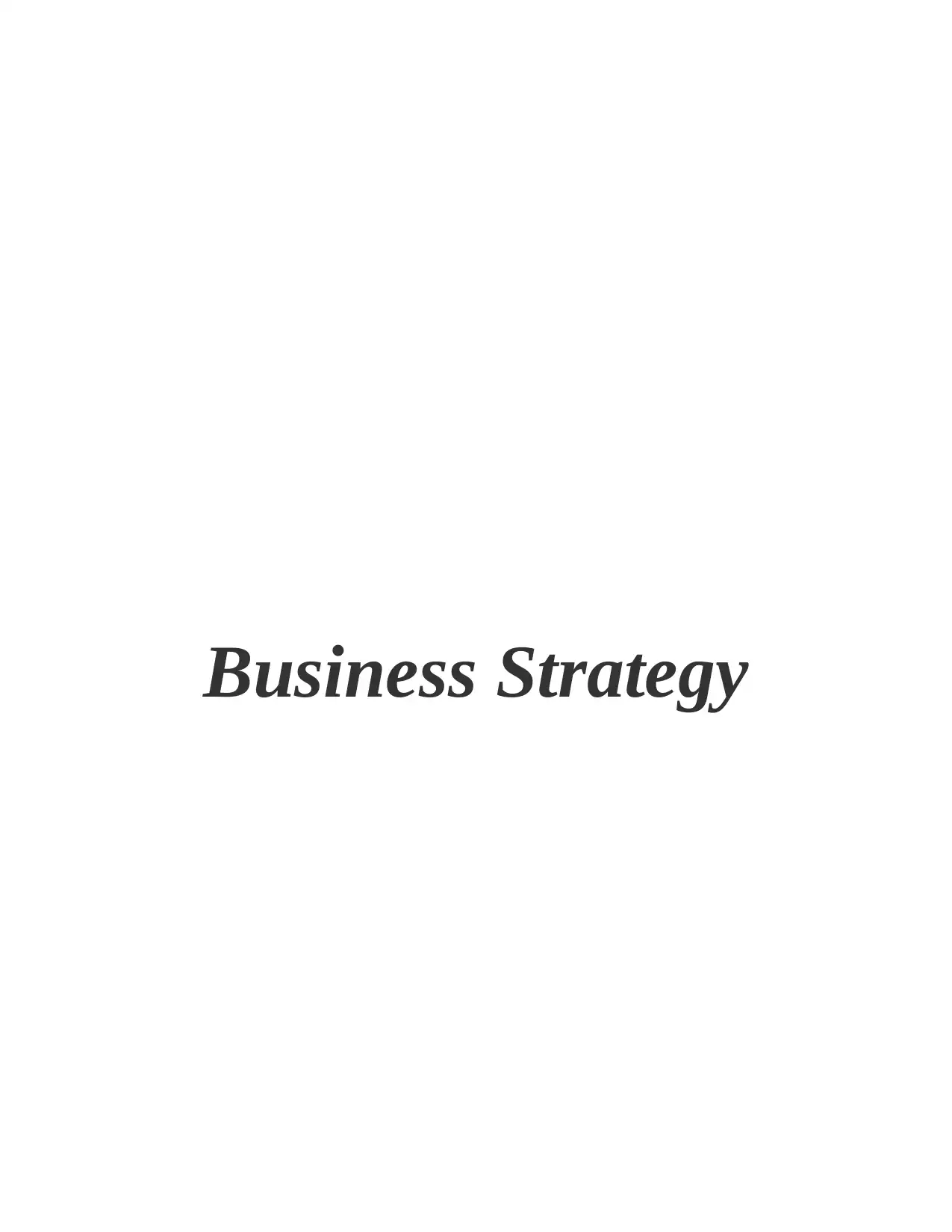
Business Strategy
Paraphrase This Document
Need a fresh take? Get an instant paraphrase of this document with our AI Paraphraser
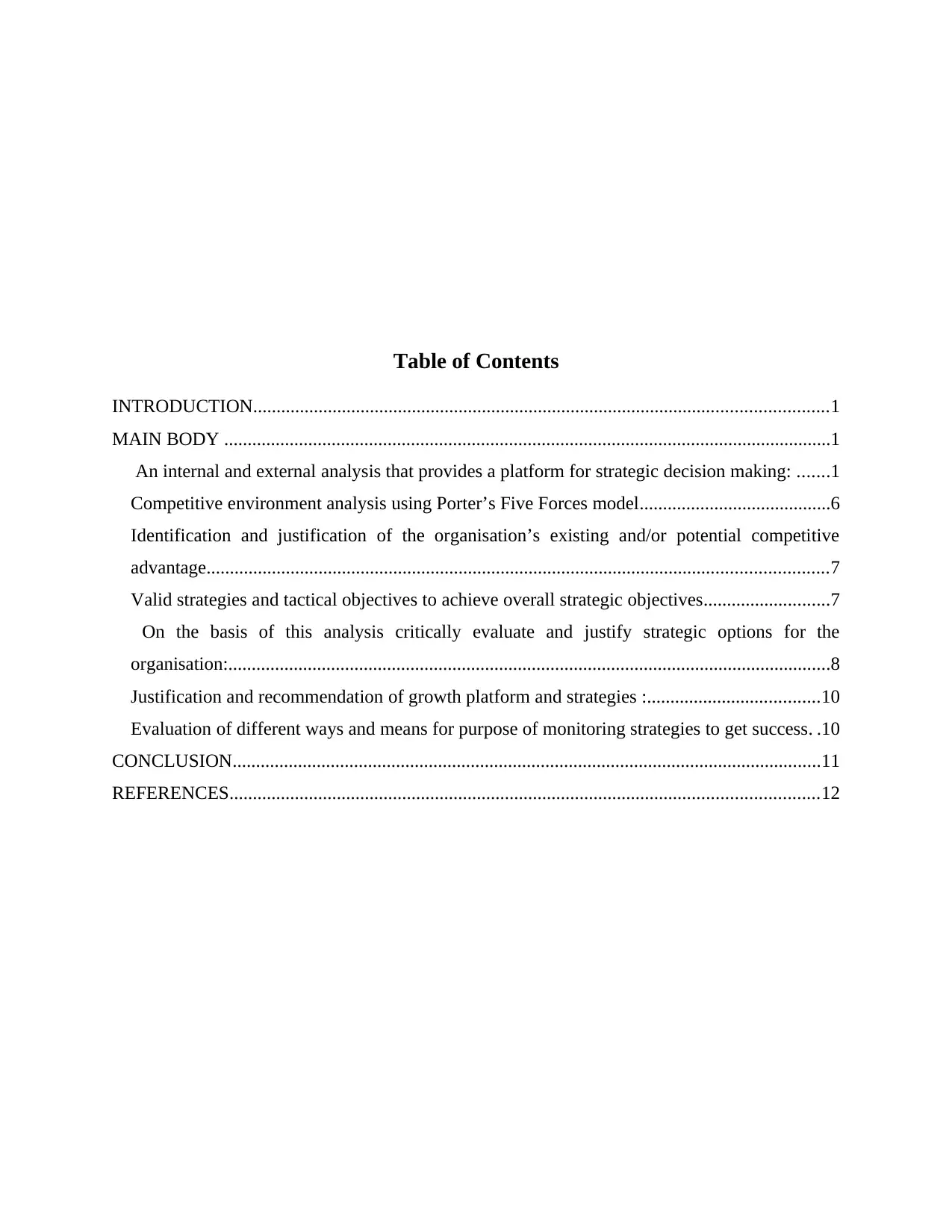
Table of Contents
INTRODUCTION...........................................................................................................................1
MAIN BODY ..................................................................................................................................1
An internal and external analysis that provides a platform for strategic decision making: .......1
Competitive environment analysis using Porter’s Five Forces model.........................................6
Identification and justification of the organisation’s existing and/or potential competitive
advantage.....................................................................................................................................7
Valid strategies and tactical objectives to achieve overall strategic objectives...........................7
On the basis of this analysis critically evaluate and justify strategic options for the
organisation:.................................................................................................................................8
Justification and recommendation of growth platform and strategies :.....................................10
Evaluation of different ways and means for purpose of monitoring strategies to get success. .10
CONCLUSION..............................................................................................................................11
REFERENCES..............................................................................................................................12
INTRODUCTION...........................................................................................................................1
MAIN BODY ..................................................................................................................................1
An internal and external analysis that provides a platform for strategic decision making: .......1
Competitive environment analysis using Porter’s Five Forces model.........................................6
Identification and justification of the organisation’s existing and/or potential competitive
advantage.....................................................................................................................................7
Valid strategies and tactical objectives to achieve overall strategic objectives...........................7
On the basis of this analysis critically evaluate and justify strategic options for the
organisation:.................................................................................................................................8
Justification and recommendation of growth platform and strategies :.....................................10
Evaluation of different ways and means for purpose of monitoring strategies to get success. .10
CONCLUSION..............................................................................................................................11
REFERENCES..............................................................................................................................12
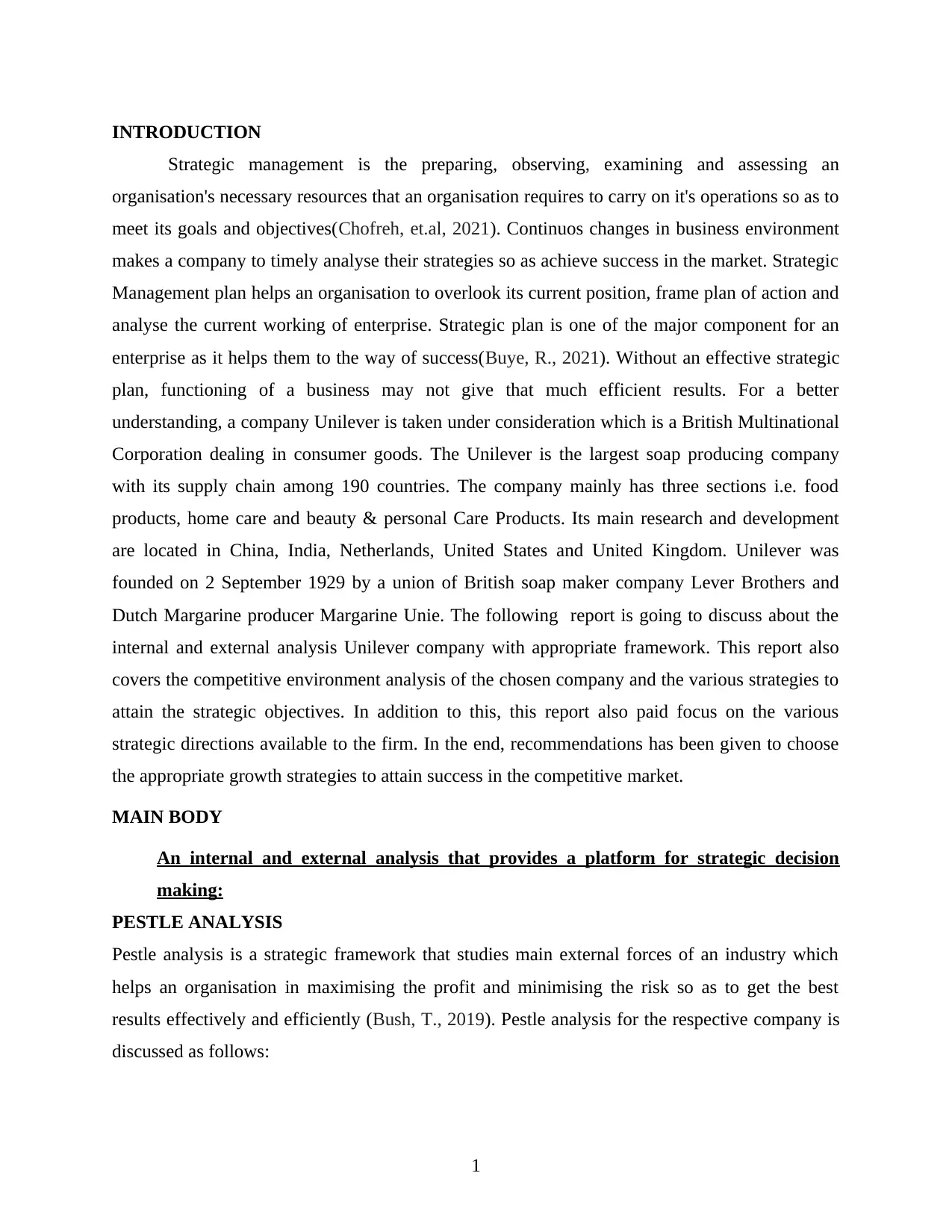
INTRODUCTION
Strategic management is the preparing, observing, examining and assessing an
organisation's necessary resources that an organisation requires to carry on it's operations so as to
meet its goals and objectives(Chofreh, et.al, 2021). Continuos changes in business environment
makes a company to timely analyse their strategies so as achieve success in the market. Strategic
Management plan helps an organisation to overlook its current position, frame plan of action and
analyse the current working of enterprise. Strategic plan is one of the major component for an
enterprise as it helps them to the way of success(Buye, R., 2021). Without an effective strategic
plan, functioning of a business may not give that much efficient results. For a better
understanding, a company Unilever is taken under consideration which is a British Multinational
Corporation dealing in consumer goods. The Unilever is the largest soap producing company
with its supply chain among 190 countries. The company mainly has three sections i.e. food
products, home care and beauty & personal Care Products. Its main research and development
are located in China, India, Netherlands, United States and United Kingdom. Unilever was
founded on 2 September 1929 by a union of British soap maker company Lever Brothers and
Dutch Margarine producer Margarine Unie. The following report is going to discuss about the
internal and external analysis Unilever company with appropriate framework. This report also
covers the competitive environment analysis of the chosen company and the various strategies to
attain the strategic objectives. In addition to this, this report also paid focus on the various
strategic directions available to the firm. In the end, recommendations has been given to choose
the appropriate growth strategies to attain success in the competitive market.
MAIN BODY
An internal and external analysis that provides a platform for strategic decision
making:
PESTLE ANALYSIS
Pestle analysis is a strategic framework that studies main external forces of an industry which
helps an organisation in maximising the profit and minimising the risk so as to get the best
results effectively and efficiently (Bush, T., 2019). Pestle analysis for the respective company is
discussed as follows:
1
Strategic management is the preparing, observing, examining and assessing an
organisation's necessary resources that an organisation requires to carry on it's operations so as to
meet its goals and objectives(Chofreh, et.al, 2021). Continuos changes in business environment
makes a company to timely analyse their strategies so as achieve success in the market. Strategic
Management plan helps an organisation to overlook its current position, frame plan of action and
analyse the current working of enterprise. Strategic plan is one of the major component for an
enterprise as it helps them to the way of success(Buye, R., 2021). Without an effective strategic
plan, functioning of a business may not give that much efficient results. For a better
understanding, a company Unilever is taken under consideration which is a British Multinational
Corporation dealing in consumer goods. The Unilever is the largest soap producing company
with its supply chain among 190 countries. The company mainly has three sections i.e. food
products, home care and beauty & personal Care Products. Its main research and development
are located in China, India, Netherlands, United States and United Kingdom. Unilever was
founded on 2 September 1929 by a union of British soap maker company Lever Brothers and
Dutch Margarine producer Margarine Unie. The following report is going to discuss about the
internal and external analysis Unilever company with appropriate framework. This report also
covers the competitive environment analysis of the chosen company and the various strategies to
attain the strategic objectives. In addition to this, this report also paid focus on the various
strategic directions available to the firm. In the end, recommendations has been given to choose
the appropriate growth strategies to attain success in the competitive market.
MAIN BODY
An internal and external analysis that provides a platform for strategic decision
making:
PESTLE ANALYSIS
Pestle analysis is a strategic framework that studies main external forces of an industry which
helps an organisation in maximising the profit and minimising the risk so as to get the best
results effectively and efficiently (Bush, T., 2019). Pestle analysis for the respective company is
discussed as follows:
1
⊘ This is a preview!⊘
Do you want full access?
Subscribe today to unlock all pages.

Trusted by 1+ million students worldwide
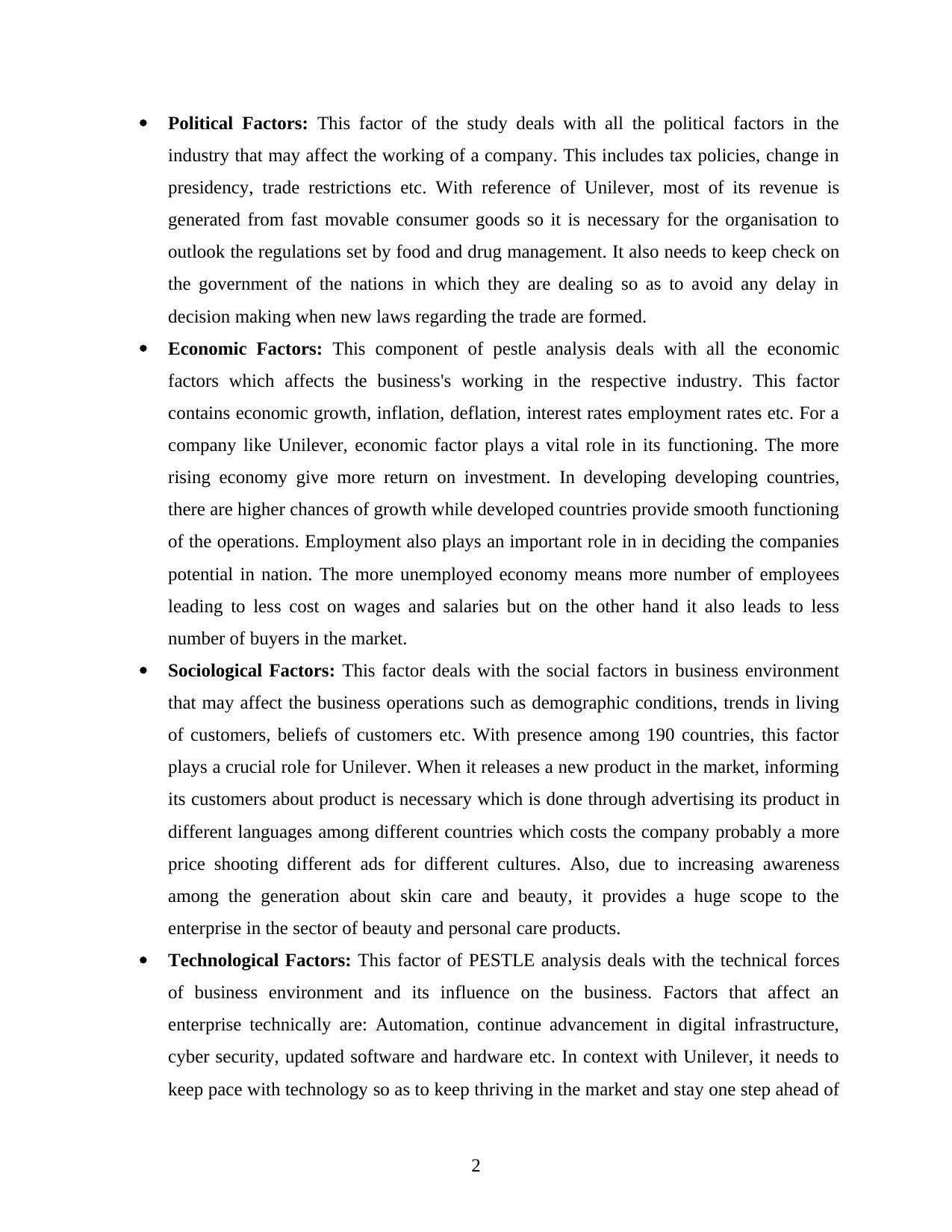
Political Factors: This factor of the study deals with all the political factors in the
industry that may affect the working of a company. This includes tax policies, change in
presidency, trade restrictions etc. With reference of Unilever, most of its revenue is
generated from fast movable consumer goods so it is necessary for the organisation to
outlook the regulations set by food and drug management. It also needs to keep check on
the government of the nations in which they are dealing so as to avoid any delay in
decision making when new laws regarding the trade are formed.
Economic Factors: This component of pestle analysis deals with all the economic
factors which affects the business's working in the respective industry. This factor
contains economic growth, inflation, deflation, interest rates employment rates etc. For a
company like Unilever, economic factor plays a vital role in its functioning. The more
rising economy give more return on investment. In developing developing countries,
there are higher chances of growth while developed countries provide smooth functioning
of the operations. Employment also plays an important role in in deciding the companies
potential in nation. The more unemployed economy means more number of employees
leading to less cost on wages and salaries but on the other hand it also leads to less
number of buyers in the market.
Sociological Factors: This factor deals with the social factors in business environment
that may affect the business operations such as demographic conditions, trends in living
of customers, beliefs of customers etc. With presence among 190 countries, this factor
plays a crucial role for Unilever. When it releases a new product in the market, informing
its customers about product is necessary which is done through advertising its product in
different languages among different countries which costs the company probably a more
price shooting different ads for different cultures. Also, due to increasing awareness
among the generation about skin care and beauty, it provides a huge scope to the
enterprise in the sector of beauty and personal care products.
Technological Factors: This factor of PESTLE analysis deals with the technical forces
of business environment and its influence on the business. Factors that affect an
enterprise technically are: Automation, continue advancement in digital infrastructure,
cyber security, updated software and hardware etc. In context with Unilever, it needs to
keep pace with technology so as to keep thriving in the market and stay one step ahead of
2
industry that may affect the working of a company. This includes tax policies, change in
presidency, trade restrictions etc. With reference of Unilever, most of its revenue is
generated from fast movable consumer goods so it is necessary for the organisation to
outlook the regulations set by food and drug management. It also needs to keep check on
the government of the nations in which they are dealing so as to avoid any delay in
decision making when new laws regarding the trade are formed.
Economic Factors: This component of pestle analysis deals with all the economic
factors which affects the business's working in the respective industry. This factor
contains economic growth, inflation, deflation, interest rates employment rates etc. For a
company like Unilever, economic factor plays a vital role in its functioning. The more
rising economy give more return on investment. In developing developing countries,
there are higher chances of growth while developed countries provide smooth functioning
of the operations. Employment also plays an important role in in deciding the companies
potential in nation. The more unemployed economy means more number of employees
leading to less cost on wages and salaries but on the other hand it also leads to less
number of buyers in the market.
Sociological Factors: This factor deals with the social factors in business environment
that may affect the business operations such as demographic conditions, trends in living
of customers, beliefs of customers etc. With presence among 190 countries, this factor
plays a crucial role for Unilever. When it releases a new product in the market, informing
its customers about product is necessary which is done through advertising its product in
different languages among different countries which costs the company probably a more
price shooting different ads for different cultures. Also, due to increasing awareness
among the generation about skin care and beauty, it provides a huge scope to the
enterprise in the sector of beauty and personal care products.
Technological Factors: This factor of PESTLE analysis deals with the technical forces
of business environment and its influence on the business. Factors that affect an
enterprise technically are: Automation, continue advancement in digital infrastructure,
cyber security, updated software and hardware etc. In context with Unilever, it needs to
keep pace with technology so as to keep thriving in the market and stay one step ahead of
2
Paraphrase This Document
Need a fresh take? Get an instant paraphrase of this document with our AI Paraphraser
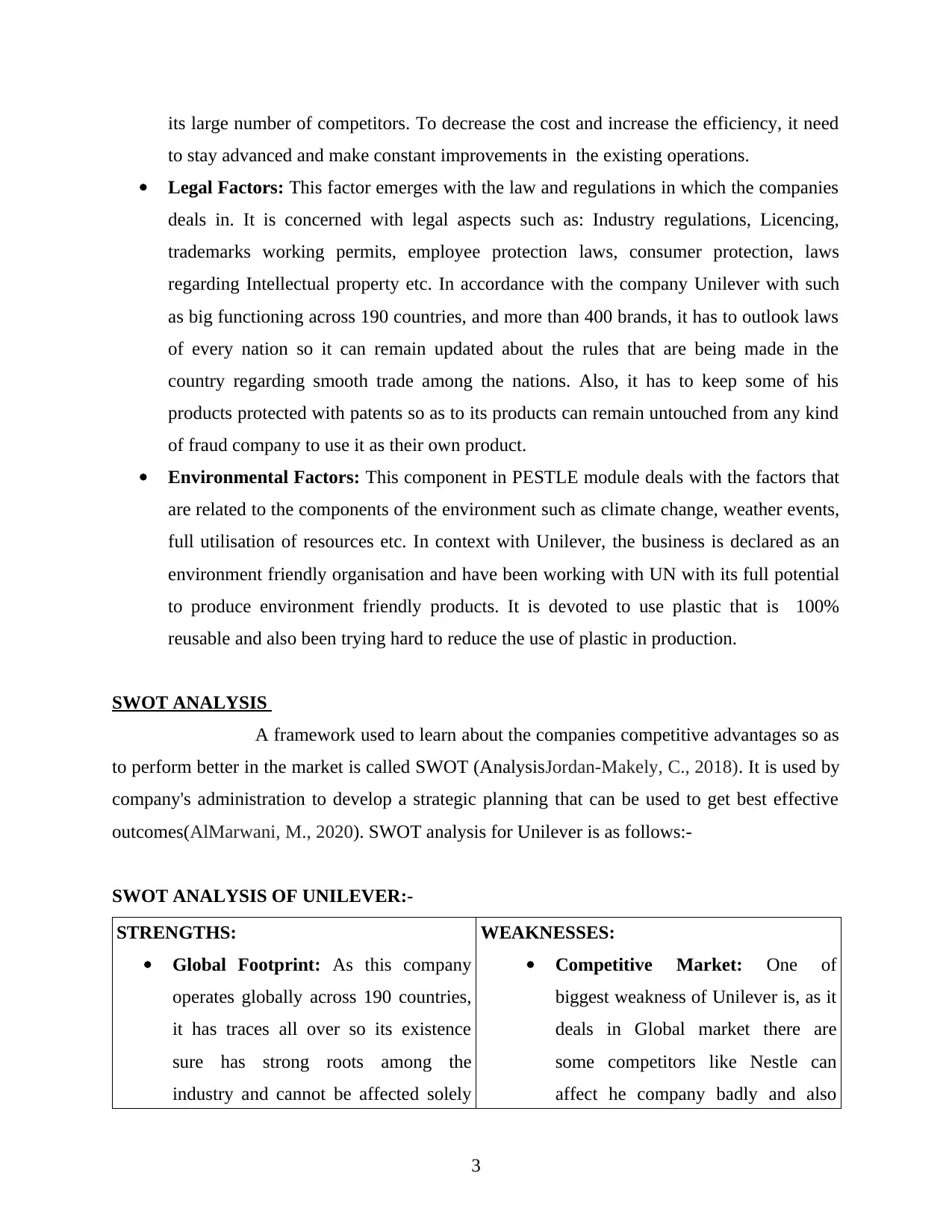
its large number of competitors. To decrease the cost and increase the efficiency, it need
to stay advanced and make constant improvements in the existing operations.
Legal Factors: This factor emerges with the law and regulations in which the companies
deals in. It is concerned with legal aspects such as: Industry regulations, Licencing,
trademarks working permits, employee protection laws, consumer protection, laws
regarding Intellectual property etc. In accordance with the company Unilever with such
as big functioning across 190 countries, and more than 400 brands, it has to outlook laws
of every nation so it can remain updated about the rules that are being made in the
country regarding smooth trade among the nations. Also, it has to keep some of his
products protected with patents so as to its products can remain untouched from any kind
of fraud company to use it as their own product.
Environmental Factors: This component in PESTLE module deals with the factors that
are related to the components of the environment such as climate change, weather events,
full utilisation of resources etc. In context with Unilever, the business is declared as an
environment friendly organisation and have been working with UN with its full potential
to produce environment friendly products. It is devoted to use plastic that is 100%
reusable and also been trying hard to reduce the use of plastic in production.
SWOT ANALYSIS
A framework used to learn about the companies competitive advantages so as
to perform better in the market is called SWOT (AnalysisJordan-Makely, C., 2018). It is used by
company's administration to develop a strategic planning that can be used to get best effective
outcomes(AlMarwani, M., 2020). SWOT analysis for Unilever is as follows:-
SWOT ANALYSIS OF UNILEVER:-
STRENGTHS:
Global Footprint: As this company
operates globally across 190 countries,
it has traces all over so its existence
sure has strong roots among the
industry and cannot be affected solely
WEAKNESSES:
Competitive Market: One of
biggest weakness of Unilever is, as it
deals in Global market there are
some competitors like Nestle can
affect he company badly and also
3
to stay advanced and make constant improvements in the existing operations.
Legal Factors: This factor emerges with the law and regulations in which the companies
deals in. It is concerned with legal aspects such as: Industry regulations, Licencing,
trademarks working permits, employee protection laws, consumer protection, laws
regarding Intellectual property etc. In accordance with the company Unilever with such
as big functioning across 190 countries, and more than 400 brands, it has to outlook laws
of every nation so it can remain updated about the rules that are being made in the
country regarding smooth trade among the nations. Also, it has to keep some of his
products protected with patents so as to its products can remain untouched from any kind
of fraud company to use it as their own product.
Environmental Factors: This component in PESTLE module deals with the factors that
are related to the components of the environment such as climate change, weather events,
full utilisation of resources etc. In context with Unilever, the business is declared as an
environment friendly organisation and have been working with UN with its full potential
to produce environment friendly products. It is devoted to use plastic that is 100%
reusable and also been trying hard to reduce the use of plastic in production.
SWOT ANALYSIS
A framework used to learn about the companies competitive advantages so as
to perform better in the market is called SWOT (AnalysisJordan-Makely, C., 2018). It is used by
company's administration to develop a strategic planning that can be used to get best effective
outcomes(AlMarwani, M., 2020). SWOT analysis for Unilever is as follows:-
SWOT ANALYSIS OF UNILEVER:-
STRENGTHS:
Global Footprint: As this company
operates globally across 190 countries,
it has traces all over so its existence
sure has strong roots among the
industry and cannot be affected solely
WEAKNESSES:
Competitive Market: One of
biggest weakness of Unilever is, as it
deals in Global market there are
some competitors like Nestle can
affect he company badly and also
3
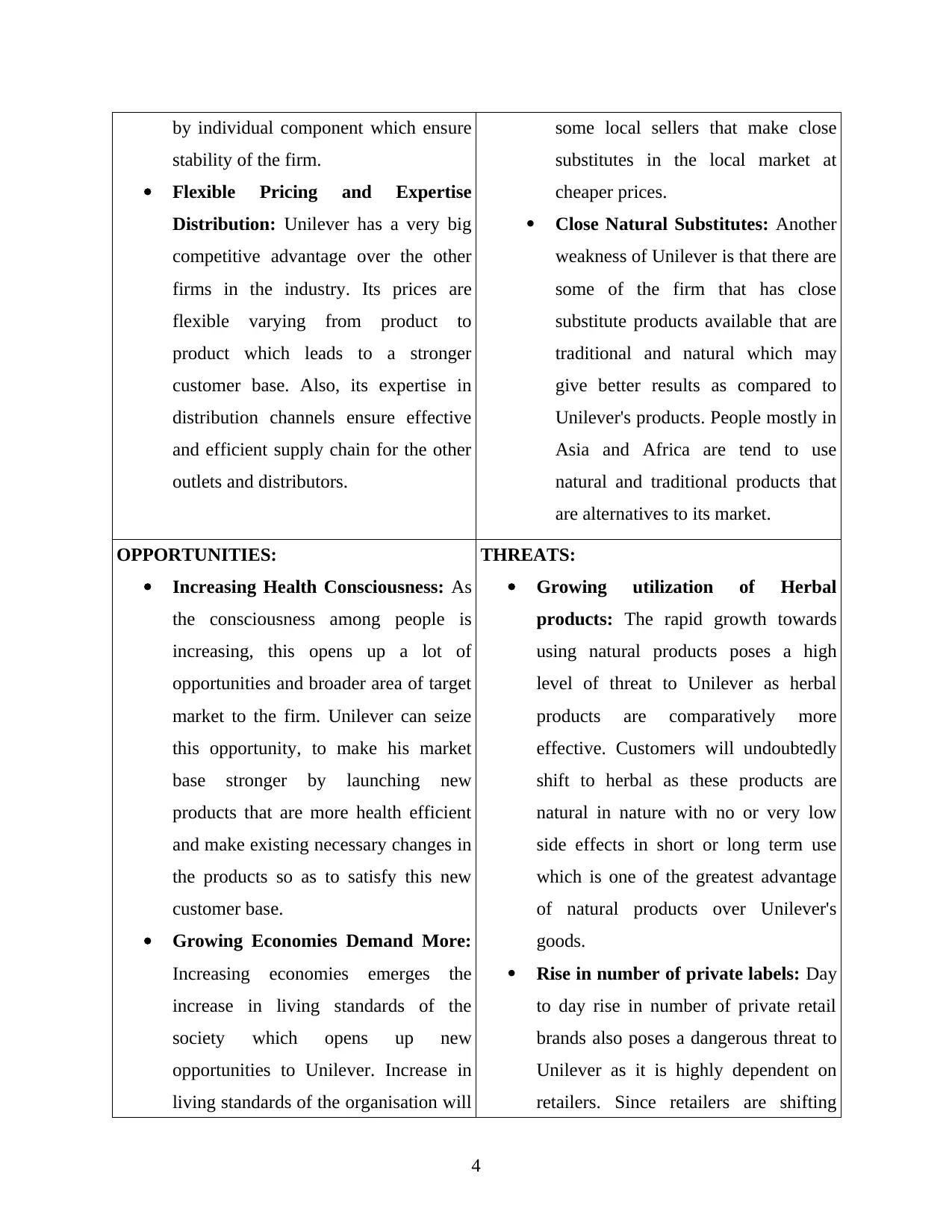
by individual component which ensure
stability of the firm.
Flexible Pricing and Expertise
Distribution: Unilever has a very big
competitive advantage over the other
firms in the industry. Its prices are
flexible varying from product to
product which leads to a stronger
customer base. Also, its expertise in
distribution channels ensure effective
and efficient supply chain for the other
outlets and distributors.
some local sellers that make close
substitutes in the local market at
cheaper prices.
Close Natural Substitutes: Another
weakness of Unilever is that there are
some of the firm that has close
substitute products available that are
traditional and natural which may
give better results as compared to
Unilever's products. People mostly in
Asia and Africa are tend to use
natural and traditional products that
are alternatives to its market.
OPPORTUNITIES:
Increasing Health Consciousness: As
the consciousness among people is
increasing, this opens up a lot of
opportunities and broader area of target
market to the firm. Unilever can seize
this opportunity, to make his market
base stronger by launching new
products that are more health efficient
and make existing necessary changes in
the products so as to satisfy this new
customer base.
Growing Economies Demand More:
Increasing economies emerges the
increase in living standards of the
society which opens up new
opportunities to Unilever. Increase in
living standards of the organisation will
THREATS:
Growing utilization of Herbal
products: The rapid growth towards
using natural products poses a high
level of threat to Unilever as herbal
products are comparatively more
effective. Customers will undoubtedly
shift to herbal as these products are
natural in nature with no or very low
side effects in short or long term use
which is one of the greatest advantage
of natural products over Unilever's
goods.
Rise in number of private labels: Day
to day rise in number of private retail
brands also poses a dangerous threat to
Unilever as it is highly dependent on
retailers. Since retailers are shifting
4
stability of the firm.
Flexible Pricing and Expertise
Distribution: Unilever has a very big
competitive advantage over the other
firms in the industry. Its prices are
flexible varying from product to
product which leads to a stronger
customer base. Also, its expertise in
distribution channels ensure effective
and efficient supply chain for the other
outlets and distributors.
some local sellers that make close
substitutes in the local market at
cheaper prices.
Close Natural Substitutes: Another
weakness of Unilever is that there are
some of the firm that has close
substitute products available that are
traditional and natural which may
give better results as compared to
Unilever's products. People mostly in
Asia and Africa are tend to use
natural and traditional products that
are alternatives to its market.
OPPORTUNITIES:
Increasing Health Consciousness: As
the consciousness among people is
increasing, this opens up a lot of
opportunities and broader area of target
market to the firm. Unilever can seize
this opportunity, to make his market
base stronger by launching new
products that are more health efficient
and make existing necessary changes in
the products so as to satisfy this new
customer base.
Growing Economies Demand More:
Increasing economies emerges the
increase in living standards of the
society which opens up new
opportunities to Unilever. Increase in
living standards of the organisation will
THREATS:
Growing utilization of Herbal
products: The rapid growth towards
using natural products poses a high
level of threat to Unilever as herbal
products are comparatively more
effective. Customers will undoubtedly
shift to herbal as these products are
natural in nature with no or very low
side effects in short or long term use
which is one of the greatest advantage
of natural products over Unilever's
goods.
Rise in number of private labels: Day
to day rise in number of private retail
brands also poses a dangerous threat to
Unilever as it is highly dependent on
retailers. Since retailers are shifting
4
⊘ This is a preview!⊘
Do you want full access?
Subscribe today to unlock all pages.

Trusted by 1+ million students worldwide
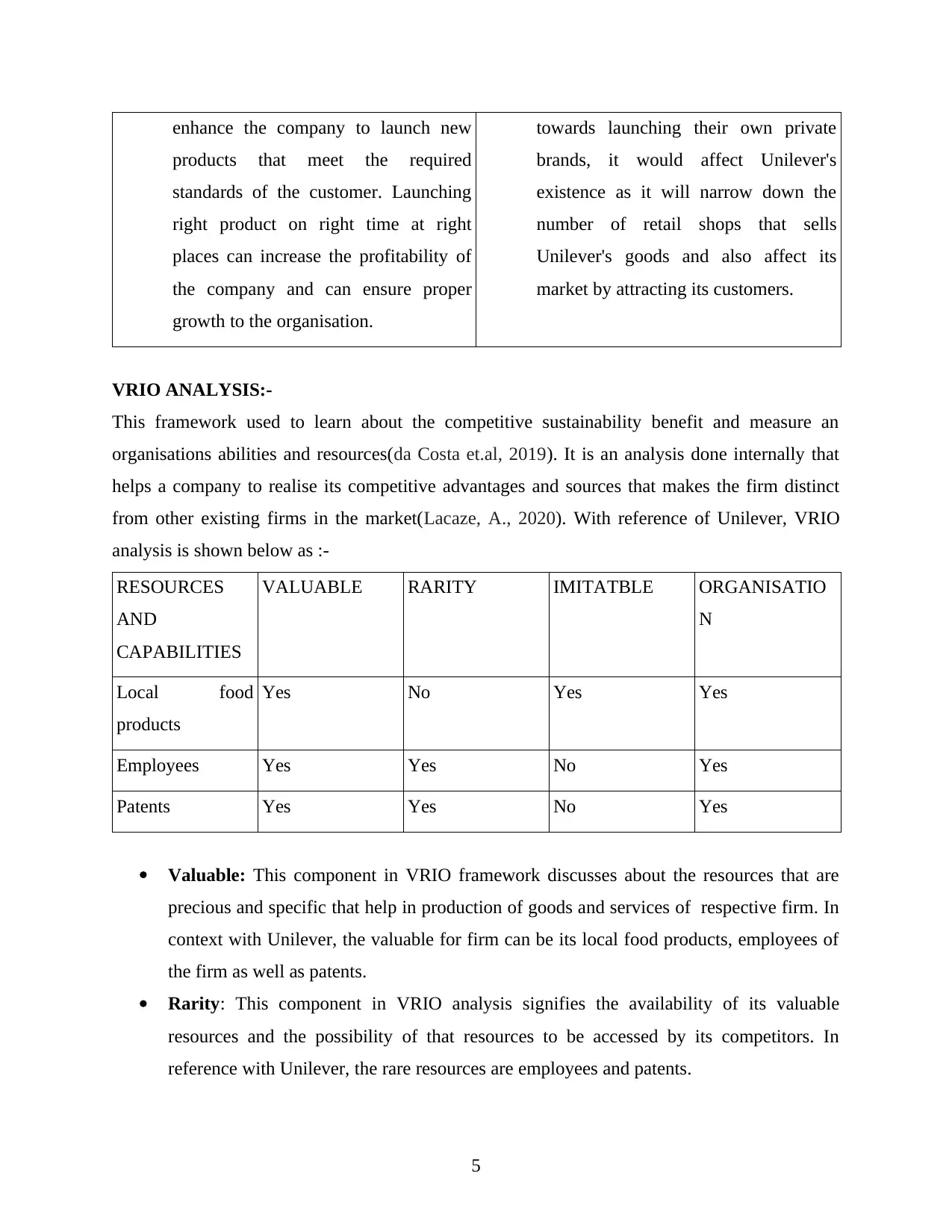
enhance the company to launch new
products that meet the required
standards of the customer. Launching
right product on right time at right
places can increase the profitability of
the company and can ensure proper
growth to the organisation.
towards launching their own private
brands, it would affect Unilever's
existence as it will narrow down the
number of retail shops that sells
Unilever's goods and also affect its
market by attracting its customers.
VRIO ANALYSIS:-
This framework used to learn about the competitive sustainability benefit and measure an
organisations abilities and resources(da Costa et.al, 2019). It is an analysis done internally that
helps a company to realise its competitive advantages and sources that makes the firm distinct
from other existing firms in the market(Lacaze, A., 2020). With reference of Unilever, VRIO
analysis is shown below as :-
RESOURCES
AND
CAPABILITIES
VALUABLE RARITY IMITATBLE ORGANISATIO
N
Local food
products
Yes No Yes Yes
Employees Yes Yes No Yes
Patents Yes Yes No Yes
Valuable: This component in VRIO framework discusses about the resources that are
precious and specific that help in production of goods and services of respective firm. In
context with Unilever, the valuable for firm can be its local food products, employees of
the firm as well as patents.
Rarity: This component in VRIO analysis signifies the availability of its valuable
resources and the possibility of that resources to be accessed by its competitors. In
reference with Unilever, the rare resources are employees and patents.
5
products that meet the required
standards of the customer. Launching
right product on right time at right
places can increase the profitability of
the company and can ensure proper
growth to the organisation.
towards launching their own private
brands, it would affect Unilever's
existence as it will narrow down the
number of retail shops that sells
Unilever's goods and also affect its
market by attracting its customers.
VRIO ANALYSIS:-
This framework used to learn about the competitive sustainability benefit and measure an
organisations abilities and resources(da Costa et.al, 2019). It is an analysis done internally that
helps a company to realise its competitive advantages and sources that makes the firm distinct
from other existing firms in the market(Lacaze, A., 2020). With reference of Unilever, VRIO
analysis is shown below as :-
RESOURCES
AND
CAPABILITIES
VALUABLE RARITY IMITATBLE ORGANISATIO
N
Local food
products
Yes No Yes Yes
Employees Yes Yes No Yes
Patents Yes Yes No Yes
Valuable: This component in VRIO framework discusses about the resources that are
precious and specific that help in production of goods and services of respective firm. In
context with Unilever, the valuable for firm can be its local food products, employees of
the firm as well as patents.
Rarity: This component in VRIO analysis signifies the availability of its valuable
resources and the possibility of that resources to be accessed by its competitors. In
reference with Unilever, the rare resources are employees and patents.
5
Paraphrase This Document
Need a fresh take? Get an instant paraphrase of this document with our AI Paraphraser
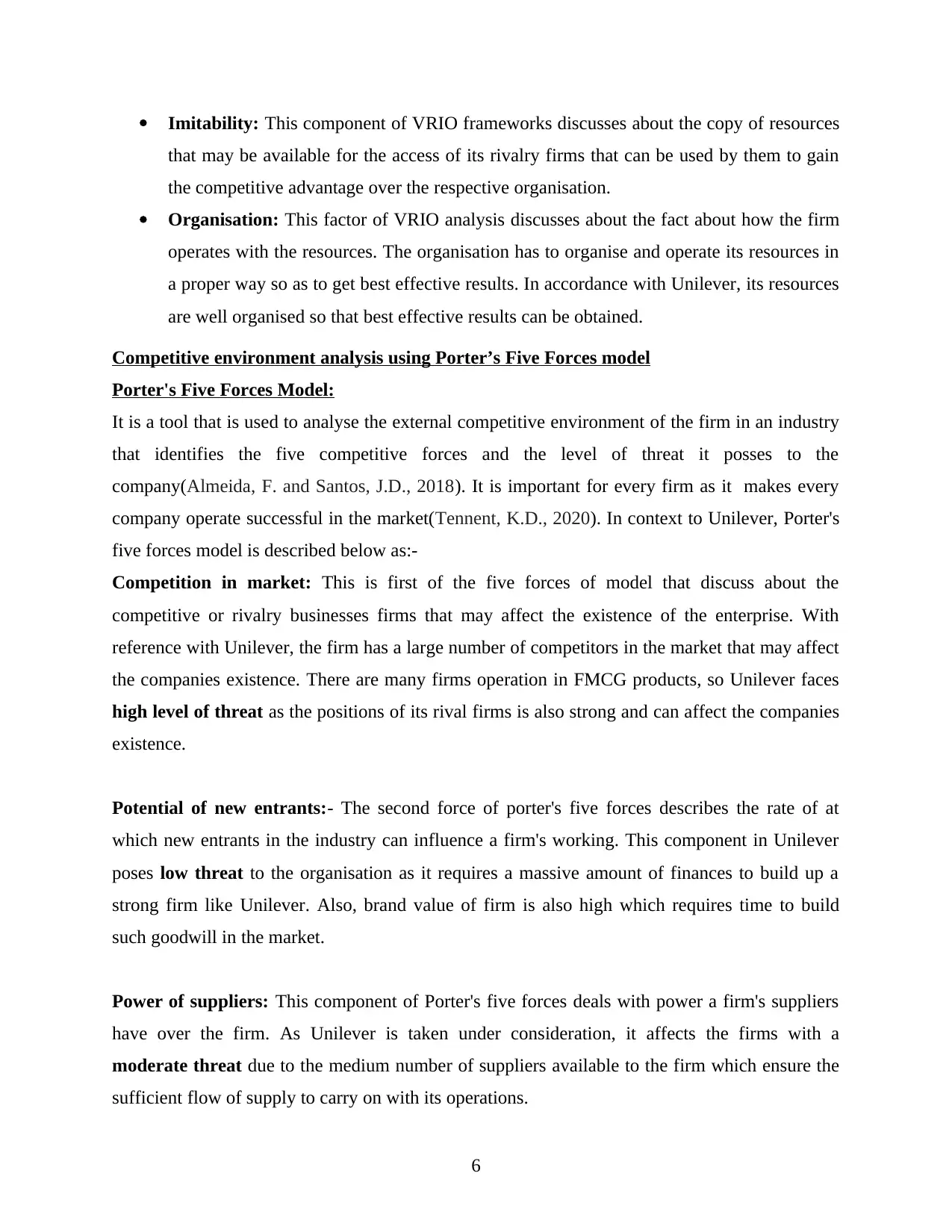
Imitability: This component of VRIO frameworks discusses about the copy of resources
that may be available for the access of its rivalry firms that can be used by them to gain
the competitive advantage over the respective organisation.
Organisation: This factor of VRIO analysis discusses about the fact about how the firm
operates with the resources. The organisation has to organise and operate its resources in
a proper way so as to get best effective results. In accordance with Unilever, its resources
are well organised so that best effective results can be obtained.
Competitive environment analysis using Porter’s Five Forces model
Porter's Five Forces Model:
It is a tool that is used to analyse the external competitive environment of the firm in an industry
that identifies the five competitive forces and the level of threat it posses to the
company(Almeida, F. and Santos, J.D., 2018). It is important for every firm as it makes every
company operate successful in the market(Tennent, K.D., 2020). In context to Unilever, Porter's
five forces model is described below as:-
Competition in market: This is first of the five forces of model that discuss about the
competitive or rivalry businesses firms that may affect the existence of the enterprise. With
reference with Unilever, the firm has a large number of competitors in the market that may affect
the companies existence. There are many firms operation in FMCG products, so Unilever faces
high level of threat as the positions of its rival firms is also strong and can affect the companies
existence.
Potential of new entrants:- The second force of porter's five forces describes the rate of at
which new entrants in the industry can influence a firm's working. This component in Unilever
poses low threat to the organisation as it requires a massive amount of finances to build up a
strong firm like Unilever. Also, brand value of firm is also high which requires time to build
such goodwill in the market.
Power of suppliers: This component of Porter's five forces deals with power a firm's suppliers
have over the firm. As Unilever is taken under consideration, it affects the firms with a
moderate threat due to the medium number of suppliers available to the firm which ensure the
sufficient flow of supply to carry on with its operations.
6
that may be available for the access of its rivalry firms that can be used by them to gain
the competitive advantage over the respective organisation.
Organisation: This factor of VRIO analysis discusses about the fact about how the firm
operates with the resources. The organisation has to organise and operate its resources in
a proper way so as to get best effective results. In accordance with Unilever, its resources
are well organised so that best effective results can be obtained.
Competitive environment analysis using Porter’s Five Forces model
Porter's Five Forces Model:
It is a tool that is used to analyse the external competitive environment of the firm in an industry
that identifies the five competitive forces and the level of threat it posses to the
company(Almeida, F. and Santos, J.D., 2018). It is important for every firm as it makes every
company operate successful in the market(Tennent, K.D., 2020). In context to Unilever, Porter's
five forces model is described below as:-
Competition in market: This is first of the five forces of model that discuss about the
competitive or rivalry businesses firms that may affect the existence of the enterprise. With
reference with Unilever, the firm has a large number of competitors in the market that may affect
the companies existence. There are many firms operation in FMCG products, so Unilever faces
high level of threat as the positions of its rival firms is also strong and can affect the companies
existence.
Potential of new entrants:- The second force of porter's five forces describes the rate of at
which new entrants in the industry can influence a firm's working. This component in Unilever
poses low threat to the organisation as it requires a massive amount of finances to build up a
strong firm like Unilever. Also, brand value of firm is also high which requires time to build
such goodwill in the market.
Power of suppliers: This component of Porter's five forces deals with power a firm's suppliers
have over the firm. As Unilever is taken under consideration, it affects the firms with a
moderate threat due to the medium number of suppliers available to the firm which ensure the
sufficient flow of supply to carry on with its operations.
6
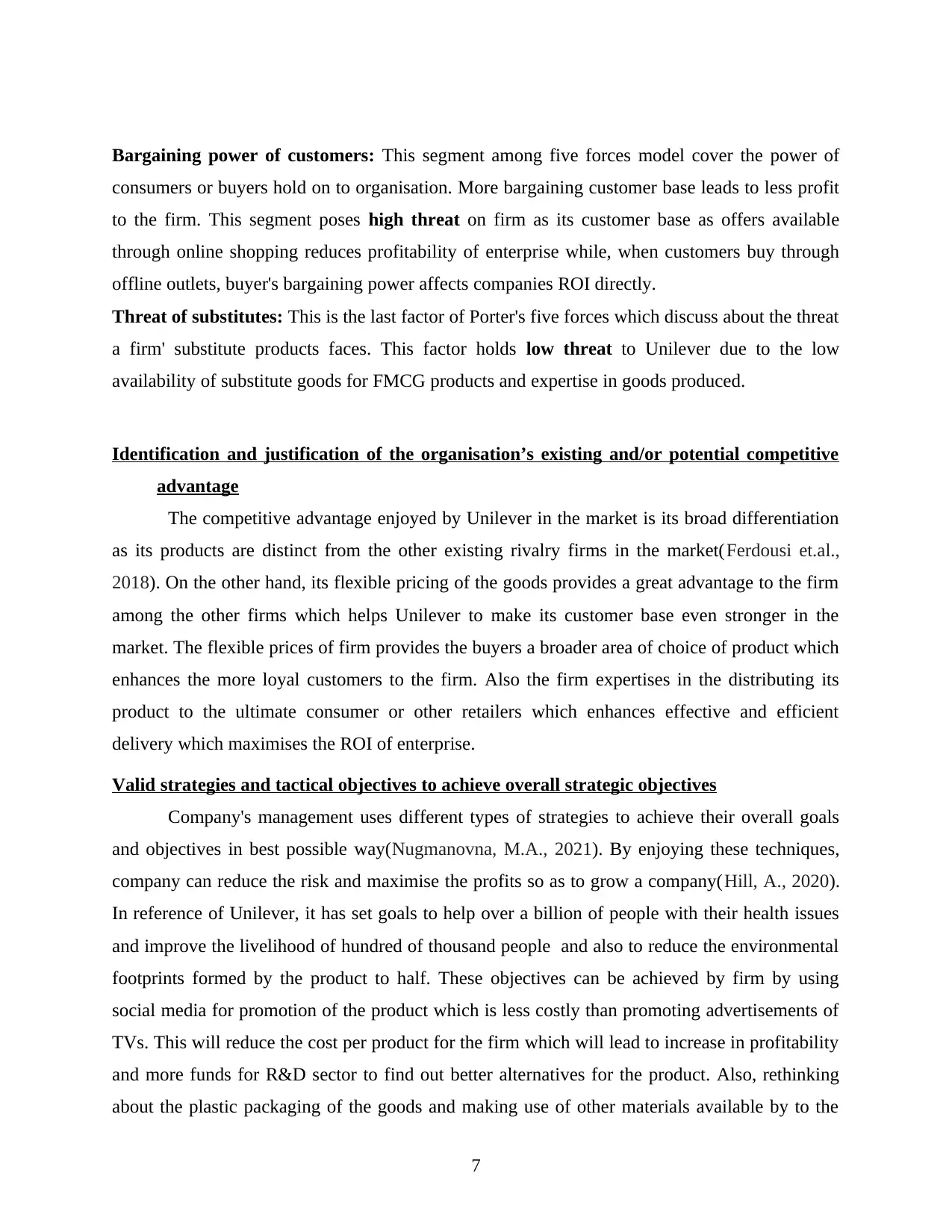
Bargaining power of customers: This segment among five forces model cover the power of
consumers or buyers hold on to organisation. More bargaining customer base leads to less profit
to the firm. This segment poses high threat on firm as its customer base as offers available
through online shopping reduces profitability of enterprise while, when customers buy through
offline outlets, buyer's bargaining power affects companies ROI directly.
Threat of substitutes: This is the last factor of Porter's five forces which discuss about the threat
a firm' substitute products faces. This factor holds low threat to Unilever due to the low
availability of substitute goods for FMCG products and expertise in goods produced.
Identification and justification of the organisation’s existing and/or potential competitive
advantage
The competitive advantage enjoyed by Unilever in the market is its broad differentiation
as its products are distinct from the other existing rivalry firms in the market(Ferdousi et.al.,
2018). On the other hand, its flexible pricing of the goods provides a great advantage to the firm
among the other firms which helps Unilever to make its customer base even stronger in the
market. The flexible prices of firm provides the buyers a broader area of choice of product which
enhances the more loyal customers to the firm. Also the firm expertises in the distributing its
product to the ultimate consumer or other retailers which enhances effective and efficient
delivery which maximises the ROI of enterprise.
Valid strategies and tactical objectives to achieve overall strategic objectives
Company's management uses different types of strategies to achieve their overall goals
and objectives in best possible way(Nugmanovna, M.A., 2021). By enjoying these techniques,
company can reduce the risk and maximise the profits so as to grow a company(Hill, A., 2020).
In reference of Unilever, it has set goals to help over a billion of people with their health issues
and improve the livelihood of hundred of thousand people and also to reduce the environmental
footprints formed by the product to half. These objectives can be achieved by firm by using
social media for promotion of the product which is less costly than promoting advertisements of
TVs. This will reduce the cost per product for the firm which will lead to increase in profitability
and more funds for R&D sector to find out better alternatives for the product. Also, rethinking
about the plastic packaging of the goods and making use of other materials available by to the
7
consumers or buyers hold on to organisation. More bargaining customer base leads to less profit
to the firm. This segment poses high threat on firm as its customer base as offers available
through online shopping reduces profitability of enterprise while, when customers buy through
offline outlets, buyer's bargaining power affects companies ROI directly.
Threat of substitutes: This is the last factor of Porter's five forces which discuss about the threat
a firm' substitute products faces. This factor holds low threat to Unilever due to the low
availability of substitute goods for FMCG products and expertise in goods produced.
Identification and justification of the organisation’s existing and/or potential competitive
advantage
The competitive advantage enjoyed by Unilever in the market is its broad differentiation
as its products are distinct from the other existing rivalry firms in the market(Ferdousi et.al.,
2018). On the other hand, its flexible pricing of the goods provides a great advantage to the firm
among the other firms which helps Unilever to make its customer base even stronger in the
market. The flexible prices of firm provides the buyers a broader area of choice of product which
enhances the more loyal customers to the firm. Also the firm expertises in the distributing its
product to the ultimate consumer or other retailers which enhances effective and efficient
delivery which maximises the ROI of enterprise.
Valid strategies and tactical objectives to achieve overall strategic objectives
Company's management uses different types of strategies to achieve their overall goals
and objectives in best possible way(Nugmanovna, M.A., 2021). By enjoying these techniques,
company can reduce the risk and maximise the profits so as to grow a company(Hill, A., 2020).
In reference of Unilever, it has set goals to help over a billion of people with their health issues
and improve the livelihood of hundred of thousand people and also to reduce the environmental
footprints formed by the product to half. These objectives can be achieved by firm by using
social media for promotion of the product which is less costly than promoting advertisements of
TVs. This will reduce the cost per product for the firm which will lead to increase in profitability
and more funds for R&D sector to find out better alternatives for the product. Also, rethinking
about the plastic packaging of the goods and making use of other materials available by to the
7
⊘ This is a preview!⊘
Do you want full access?
Subscribe today to unlock all pages.

Trusted by 1+ million students worldwide

firm will help enterprise to reduce the burden on environment. By following the strategies stated
above, overall objectives can be attained by the firm.
On the basis of this analysis critically evaluate and justify strategic options for the
organisation:
For an organisation's success, analysing a business's strategy play an important part as it
helps company to understand and evaluate a company”s current strength and also enhances it to
take a look on other available strategic options so as company can overcome with best effective
results(Kunc, M. and O’brien, F.A., 2019). It is important for a company's managers to inherit
different strategies to reduce complexities in the operations. To learn about Unilever's strategic
direction, Bowman's clock & Poster's Generic are being discussed below:-
Bowman's Strategy Clock:-
Bowman's strategy clock is a encompassing tool to evaluate an organisation's marketing
standings within price values(Dănălache, F., 2018). For Unilever, Bowman's Strategy Clock
analysis is done below as:-
1. Low prices and low value added:- This strategy of Bowman deals with company's
quantity measure to provide products at low value at the lowest price possible. In context
with Unilever, this strategy will help them to increase their market base and help them to
generate new customers.
2. Low Price:- This is the strategy to increase the quantity of production so as to reduce the
cost of goods produce in order to intensify profits of the company. This strategy will help
Unilever to increase its profit margin and also to lower the cost of goods so as to attain
growth at higher pace.
3. Hybrid:- This strategy ensure the value added products provided at lowest prices that can
be offered to buyers. This strategy will help Unilever to enhance the value of the product
offered to the customers ensuring more loyal buyers to enterprise.
4. Differentiation:- This scheme deals with the unique quality of goods that can be added
to the core product. With the help of this Unilever can add a unique item to its product
that will help them to add a unique variable to its main products ensuring its products
different from other competitors in the market.
5. Focused Differentiation:- This technique refers to providing high value products to its
customers at higher prices. It is mainly used by organisations who provide premium or
8
above, overall objectives can be attained by the firm.
On the basis of this analysis critically evaluate and justify strategic options for the
organisation:
For an organisation's success, analysing a business's strategy play an important part as it
helps company to understand and evaluate a company”s current strength and also enhances it to
take a look on other available strategic options so as company can overcome with best effective
results(Kunc, M. and O’brien, F.A., 2019). It is important for a company's managers to inherit
different strategies to reduce complexities in the operations. To learn about Unilever's strategic
direction, Bowman's clock & Poster's Generic are being discussed below:-
Bowman's Strategy Clock:-
Bowman's strategy clock is a encompassing tool to evaluate an organisation's marketing
standings within price values(Dănălache, F., 2018). For Unilever, Bowman's Strategy Clock
analysis is done below as:-
1. Low prices and low value added:- This strategy of Bowman deals with company's
quantity measure to provide products at low value at the lowest price possible. In context
with Unilever, this strategy will help them to increase their market base and help them to
generate new customers.
2. Low Price:- This is the strategy to increase the quantity of production so as to reduce the
cost of goods produce in order to intensify profits of the company. This strategy will help
Unilever to increase its profit margin and also to lower the cost of goods so as to attain
growth at higher pace.
3. Hybrid:- This strategy ensure the value added products provided at lowest prices that can
be offered to buyers. This strategy will help Unilever to enhance the value of the product
offered to the customers ensuring more loyal buyers to enterprise.
4. Differentiation:- This scheme deals with the unique quality of goods that can be added
to the core product. With the help of this Unilever can add a unique item to its product
that will help them to add a unique variable to its main products ensuring its products
different from other competitors in the market.
5. Focused Differentiation:- This technique refers to providing high value products to its
customers at higher prices. It is mainly used by organisations who provide premium or
8
Paraphrase This Document
Need a fresh take? Get an instant paraphrase of this document with our AI Paraphraser
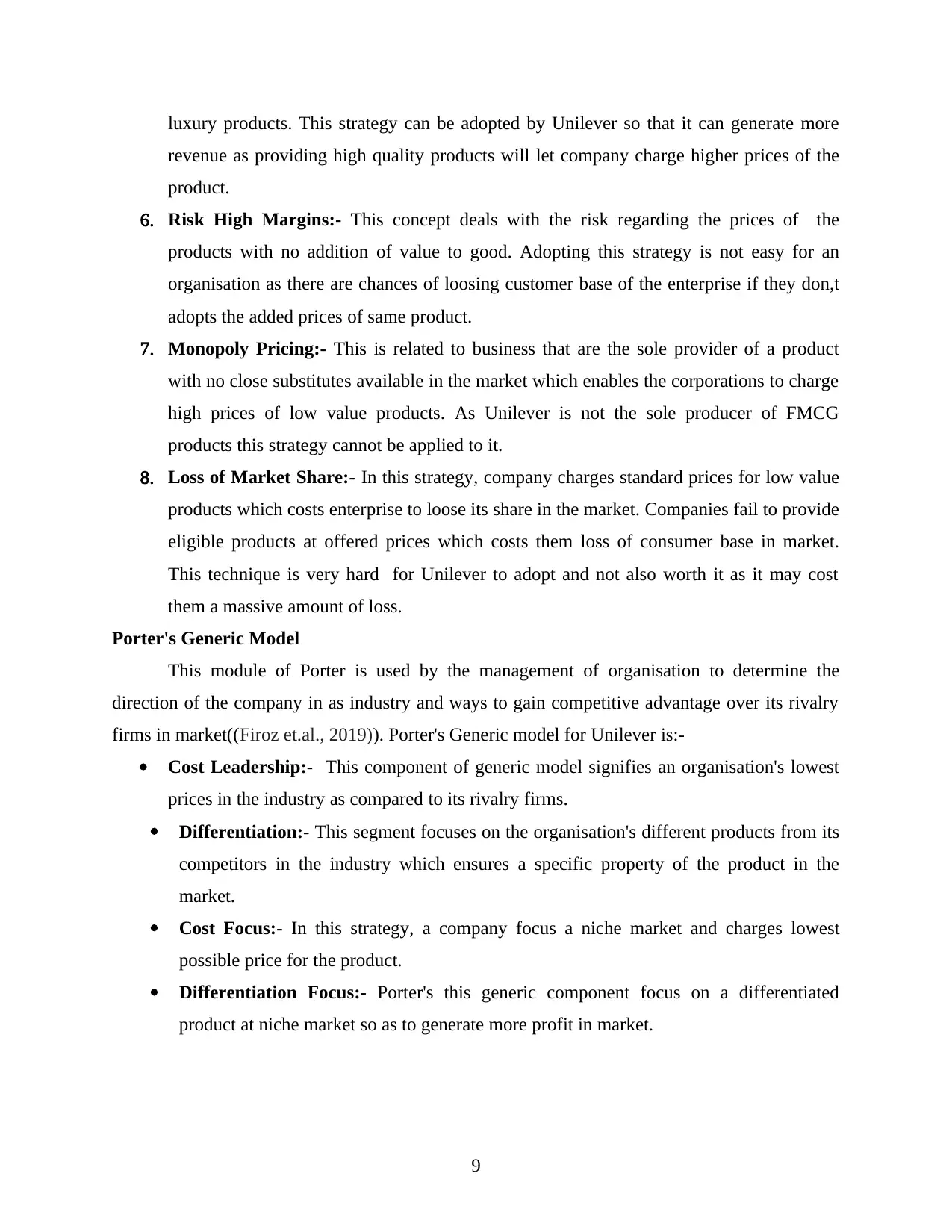
luxury products. This strategy can be adopted by Unilever so that it can generate more
revenue as providing high quality products will let company charge higher prices of the
product.
6. Risk High Margins:- This concept deals with the risk regarding the prices of the
products with no addition of value to good. Adopting this strategy is not easy for an
organisation as there are chances of loosing customer base of the enterprise if they don,t
adopts the added prices of same product.
7. Monopoly Pricing:- This is related to business that are the sole provider of a product
with no close substitutes available in the market which enables the corporations to charge
high prices of low value products. As Unilever is not the sole producer of FMCG
products this strategy cannot be applied to it.
8. Loss of Market Share:- In this strategy, company charges standard prices for low value
products which costs enterprise to loose its share in the market. Companies fail to provide
eligible products at offered prices which costs them loss of consumer base in market.
This technique is very hard for Unilever to adopt and not also worth it as it may cost
them a massive amount of loss.
Porter's Generic Model
This module of Porter is used by the management of organisation to determine the
direction of the company in as industry and ways to gain competitive advantage over its rivalry
firms in market((Firoz et.al., 2019)). Porter's Generic model for Unilever is:-
Cost Leadership:- This component of generic model signifies an organisation's lowest
prices in the industry as compared to its rivalry firms.
Differentiation:- This segment focuses on the organisation's different products from its
competitors in the industry which ensures a specific property of the product in the
market.
Cost Focus:- In this strategy, a company focus a niche market and charges lowest
possible price for the product.
Differentiation Focus:- Porter's this generic component focus on a differentiated
product at niche market so as to generate more profit in market.
9
revenue as providing high quality products will let company charge higher prices of the
product.
6. Risk High Margins:- This concept deals with the risk regarding the prices of the
products with no addition of value to good. Adopting this strategy is not easy for an
organisation as there are chances of loosing customer base of the enterprise if they don,t
adopts the added prices of same product.
7. Monopoly Pricing:- This is related to business that are the sole provider of a product
with no close substitutes available in the market which enables the corporations to charge
high prices of low value products. As Unilever is not the sole producer of FMCG
products this strategy cannot be applied to it.
8. Loss of Market Share:- In this strategy, company charges standard prices for low value
products which costs enterprise to loose its share in the market. Companies fail to provide
eligible products at offered prices which costs them loss of consumer base in market.
This technique is very hard for Unilever to adopt and not also worth it as it may cost
them a massive amount of loss.
Porter's Generic Model
This module of Porter is used by the management of organisation to determine the
direction of the company in as industry and ways to gain competitive advantage over its rivalry
firms in market((Firoz et.al., 2019)). Porter's Generic model for Unilever is:-
Cost Leadership:- This component of generic model signifies an organisation's lowest
prices in the industry as compared to its rivalry firms.
Differentiation:- This segment focuses on the organisation's different products from its
competitors in the industry which ensures a specific property of the product in the
market.
Cost Focus:- In this strategy, a company focus a niche market and charges lowest
possible price for the product.
Differentiation Focus:- Porter's this generic component focus on a differentiated
product at niche market so as to generate more profit in market.
9
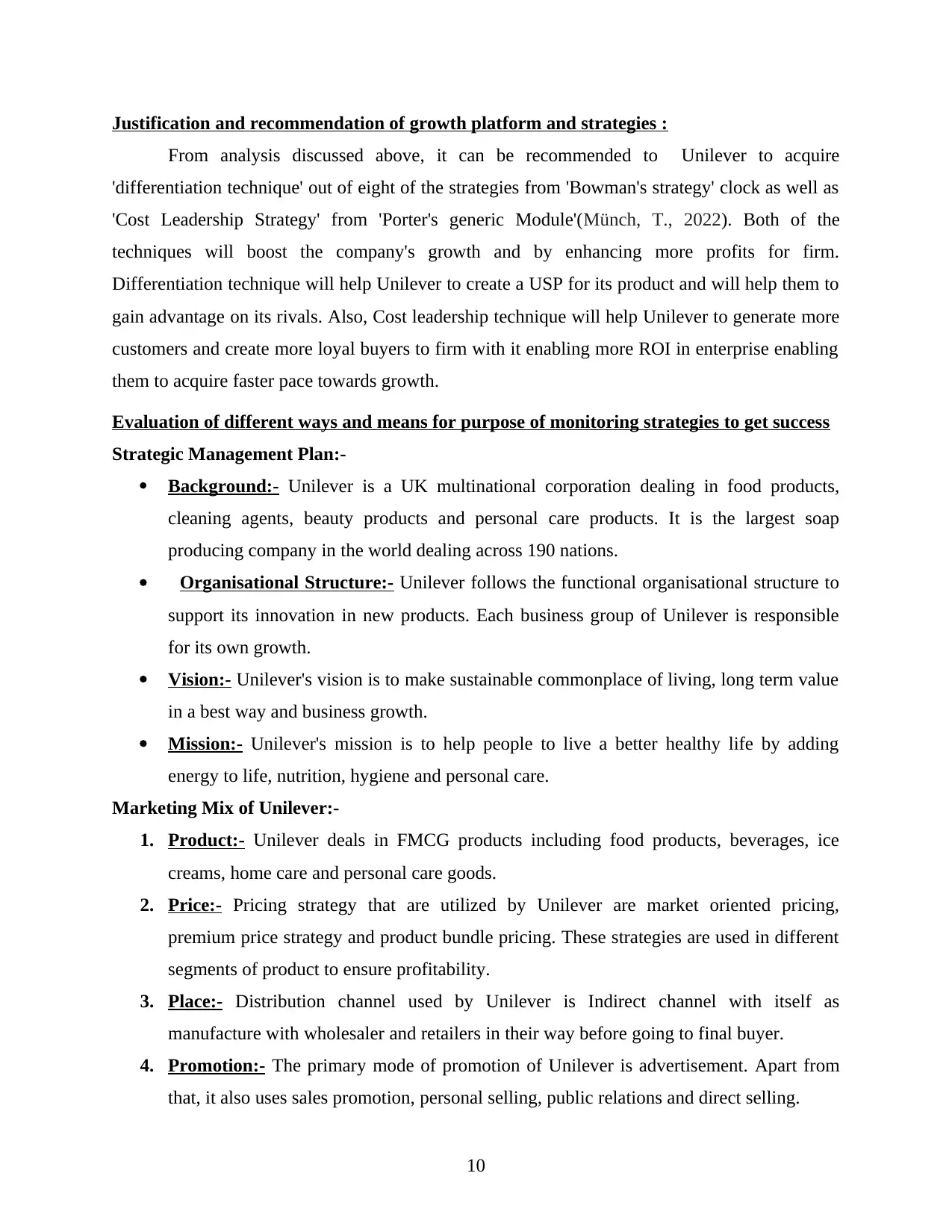
Justification and recommendation of growth platform and strategies :
From analysis discussed above, it can be recommended to Unilever to acquire
'differentiation technique' out of eight of the strategies from 'Bowman's strategy' clock as well as
'Cost Leadership Strategy' from 'Porter's generic Module'(Münch, T., 2022). Both of the
techniques will boost the company's growth and by enhancing more profits for firm.
Differentiation technique will help Unilever to create a USP for its product and will help them to
gain advantage on its rivals. Also, Cost leadership technique will help Unilever to generate more
customers and create more loyal buyers to firm with it enabling more ROI in enterprise enabling
them to acquire faster pace towards growth.
Evaluation of different ways and means for purpose of monitoring strategies to get success
Strategic Management Plan:-
Background:- Unilever is a UK multinational corporation dealing in food products,
cleaning agents, beauty products and personal care products. It is the largest soap
producing company in the world dealing across 190 nations.
Organisational Structure:- Unilever follows the functional organisational structure to
support its innovation in new products. Each business group of Unilever is responsible
for its own growth.
Vision:- Unilever's vision is to make sustainable commonplace of living, long term value
in a best way and business growth.
Mission:- Unilever's mission is to help people to live a better healthy life by adding
energy to life, nutrition, hygiene and personal care.
Marketing Mix of Unilever:-
1. Product:- Unilever deals in FMCG products including food products, beverages, ice
creams, home care and personal care goods.
2. Price:- Pricing strategy that are utilized by Unilever are market oriented pricing,
premium price strategy and product bundle pricing. These strategies are used in different
segments of product to ensure profitability.
3. Place:- Distribution channel used by Unilever is Indirect channel with itself as
manufacture with wholesaler and retailers in their way before going to final buyer.
4. Promotion:- The primary mode of promotion of Unilever is advertisement. Apart from
that, it also uses sales promotion, personal selling, public relations and direct selling.
10
From analysis discussed above, it can be recommended to Unilever to acquire
'differentiation technique' out of eight of the strategies from 'Bowman's strategy' clock as well as
'Cost Leadership Strategy' from 'Porter's generic Module'(Münch, T., 2022). Both of the
techniques will boost the company's growth and by enhancing more profits for firm.
Differentiation technique will help Unilever to create a USP for its product and will help them to
gain advantage on its rivals. Also, Cost leadership technique will help Unilever to generate more
customers and create more loyal buyers to firm with it enabling more ROI in enterprise enabling
them to acquire faster pace towards growth.
Evaluation of different ways and means for purpose of monitoring strategies to get success
Strategic Management Plan:-
Background:- Unilever is a UK multinational corporation dealing in food products,
cleaning agents, beauty products and personal care products. It is the largest soap
producing company in the world dealing across 190 nations.
Organisational Structure:- Unilever follows the functional organisational structure to
support its innovation in new products. Each business group of Unilever is responsible
for its own growth.
Vision:- Unilever's vision is to make sustainable commonplace of living, long term value
in a best way and business growth.
Mission:- Unilever's mission is to help people to live a better healthy life by adding
energy to life, nutrition, hygiene and personal care.
Marketing Mix of Unilever:-
1. Product:- Unilever deals in FMCG products including food products, beverages, ice
creams, home care and personal care goods.
2. Price:- Pricing strategy that are utilized by Unilever are market oriented pricing,
premium price strategy and product bundle pricing. These strategies are used in different
segments of product to ensure profitability.
3. Place:- Distribution channel used by Unilever is Indirect channel with itself as
manufacture with wholesaler and retailers in their way before going to final buyer.
4. Promotion:- The primary mode of promotion of Unilever is advertisement. Apart from
that, it also uses sales promotion, personal selling, public relations and direct selling.
10
⊘ This is a preview!⊘
Do you want full access?
Subscribe today to unlock all pages.

Trusted by 1+ million students worldwide
1 out of 15
Related Documents
Your All-in-One AI-Powered Toolkit for Academic Success.
+13062052269
info@desklib.com
Available 24*7 on WhatsApp / Email
![[object Object]](/_next/static/media/star-bottom.7253800d.svg)
Unlock your academic potential
Copyright © 2020–2025 A2Z Services. All Rights Reserved. Developed and managed by ZUCOL.



